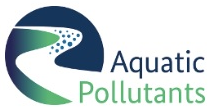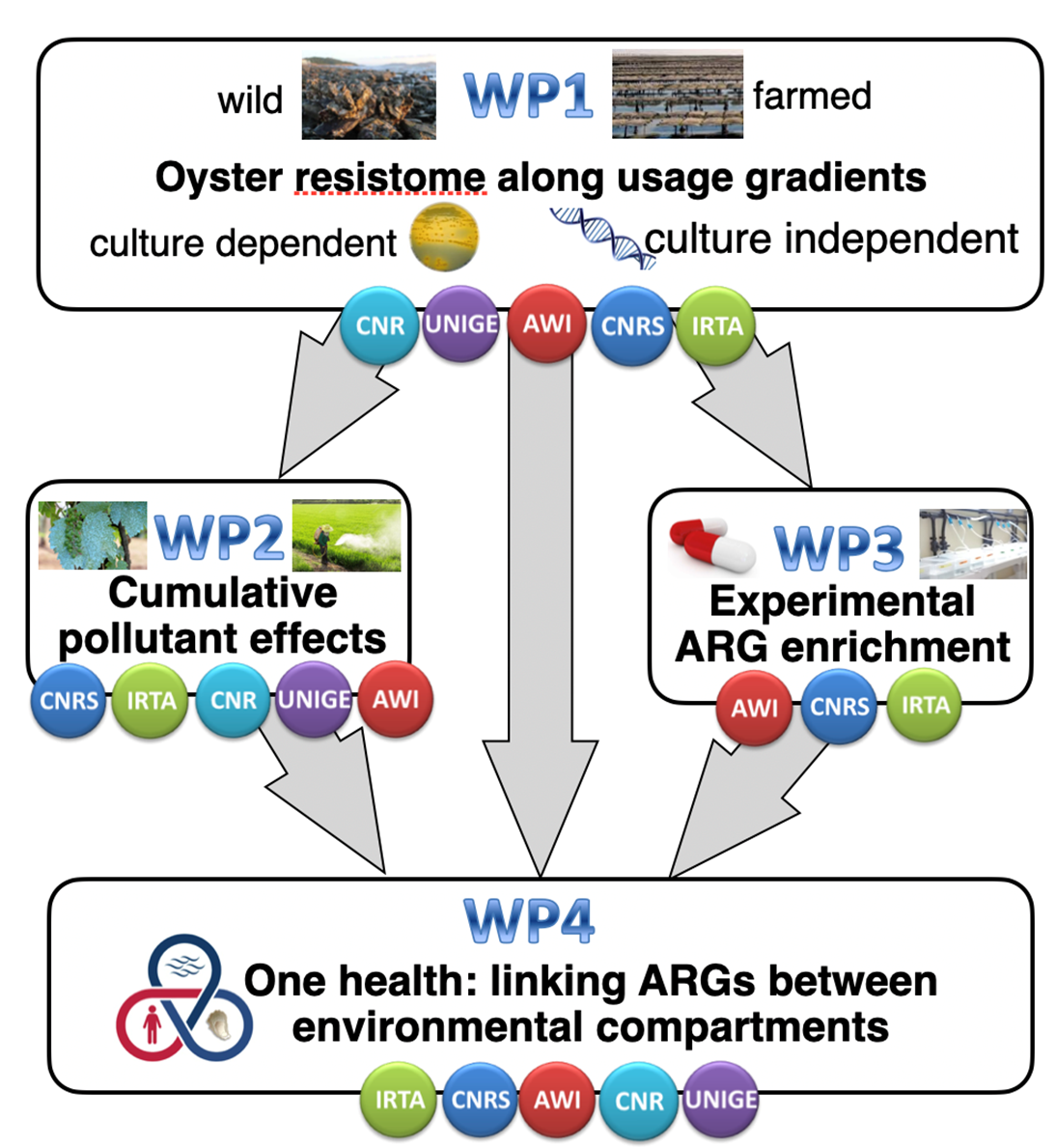 SPARE-SEA Project
SPARE-SEA Project
Environmental Spread and Persistence of Antibiotic REsistances in aquatic Systems Exposed to oyster Aquaculture
 In SPARE-SEA, a One Health approach to study the routes of transfer and the mechanisms of selection for antibiotic resistance genes within coastal habitats affected by oyster aquaculture.
In SPARE-SEA, a One Health approach to study the routes of transfer and the mechanisms of selection for antibiotic resistance genes within coastal habitats affected by oyster aquaculture.
The Goal: SPARE-SEA will provide a better picture of what antibiotic resistance genes exist in the aquatic environments where ers are cultured, how they may have arrived in this habitat, what the “drivers” are that increase their presence, and what risk this may pose to the environment, including humans – in short it is a One Health approach that puts the health of animals and humans, the environment, and our food, into the same level of scrutiny. By understanding which bacteria carry the antibiotic resistance genes and how these bacteria may be transmitted within the aquatic environment we gain knowledge that can be applied towards reducing the final impact to health at all levels. These achievements will improve health and food security and safety while reducing health risks from infectious diseases caused by bacteria.
Open Scientific Questions:
 ♦ How does early larval exposure change the oyster resistome and enrich known and emerging pathogens?
♦ How does early larval exposure change the oyster resistome and enrich known and emerging pathogens?
♦ Do human activities activate mobile genetic elements that can carry antibiotic and heavy metal resistance genes?
♦ Is the transfer of ARGs enhanced in the oyster bioreactor and what are the conditions that select for ARB in the oyster life and production cycle?
♦ Which environmental compartments are sources and sinks of ARGs transfer in coastal ecosystems?
♦ Does AR facilitate the emergence of pathogens and helps to explain the where, when and why of disease emergence?
The SPARE-SEA work plan

The SPARE-SEA Team
Updates on the project progresses are available on the SPARE-SEA twitter account: ![]() (soon available)
(soon available)
OYSTERLAND! DOWNLOAD HERE THE SPARESEA OYSTER GAME!
The Art of Bacterial Warfare: Know Thy Enemy by Karl B. Andree
Coastal waters: Does contamination by pesticides promote antibiotic-resistant bacteria?
What impact do plant protection products have on the environment and biodiversity? To attempt to answer this question, a group of experts led by INRAE and Ifremer has just published a report summarizing the overall direct and indirect effects of plant protection products on biodiversity and ecosystem services in France. Based on 4,000 reports and articles from scientific literature over the past 20 years, this report synthesizes the impacts of these substances on biodiversity and highlights a striking lack of knowledge when it comes to marine biodiversity. Beyond the impacts confirmed by collective expertise on biodiversity, there is another rather unexpected and still poorly understood one: some pesticides promote the emergence of antibiotic-resistant bacteria. The World Health Organization (WHO) considers antibiotic resistance to be 'one of the most serious threats to global health, food security, and development.'
Microbiota and antibiotic resistance
Ecosystems are populated by a multitude of microorganisms, the 'microbiota,' among which bacteria are found. Adapted to various environmental conditions, bacteria consist of many species that are present everywhere, associated with living organisms (including humans). Generally, bacteria contribute to the health of their host(s), but in some cases, they can cause diseases. Due to the threat it poses to modern medicine, the proliferation of antibiotic-resistant bacteria in the environment is becoming increasingly alarming. The overuse and/or misuse of antibiotics (which influence the selection and exchange of resistance genes with environmental microbiota) is a major factor in the spread of antibiotic-resistant bacteria.
Pesticides as selectors of antibiotic-resistant bacteria
The proliferation of antibiotic-resistant bacteria in the environment was first identified in wastewater treatment plant discharges, in groundwater contaminated by infiltrating wastewater used for crop irrigation, and on agricultural soils treated with pig slurry. It has also been documented in coastal aquaculture zones. Recent studies have revealed the role of pesticides in the development of antibiotic resistance in some natural bacterial communities in agricultural soils. Copper, in particular, used as a fungicide to protect crops (notably vineyards) or as an antifouling biocide on boat hulls, has been shown to be a powerful selector of antibiotic-resistant bacteria. It eliminates certain families of bacteria that are less resistant to antibiotics, allowing other more tolerant families to proliferate. Additionally, several herbicides tested in their commercial formulations, including glyphosate, activate cellular mechanisms of antibiotic resistance in bacteria. These herbicides make bacteria more tolerant to antibiotics than they were before exposure, even at doses lower than the recommended application rates.
What about marine environments?
Another finding of the ESCo (Collective Scientific Expertise) is that French coastal marine environments are ubiquitously contaminated by pesticides. These substances are present everywhere, in mixtures, usually at low doses but still posing a risk to living species. However, little is known about the presence of antibiotics in coastal waters, and even less about the presence of antibiotic-resistant bacteria. Yet, among bacteria tested in the laboratory, some pathogenic bacteria harmful to shellfish (such as Vibrio species) show high tolerance to antibiotics. It is now known that the richness of the internal microbiota of oysters is a factor influencing their health, much like in humans. So, if the presence of pesticides and antibiotics in coastal waters alters microbial communities in the environment, could this also negatively impact the diversity of shellfish microbiota?
The case of shellfish farming ecosystems
Marine shellfish farming ecosystems could be particularly sensitive to the issue of antibiotic resistance on several levels. First, because if some pathogenic and antibiotic-resistant bacteria proliferate in marine ecosystems, they could harm the health of the species living there, and in the case of farmed species, lead to therapeutic dead ends. Second, because the antibiotic-resistant bacteria selected in these environments also pose a risk to human health. These bacteria can enter the food chain and potentially contaminate humans through the ingestion of contaminated food or direct contact with animals. This is especially true for the consumption of raw shellfish, which is a known source of foodborne infections and could therefore carry antibiotic resistance genes into human microbiota. This is why understanding the link between antibiotic resistance and chemical pollution in shellfish farming ecosystems is crucial for anticipating future ecological and health crises. This is precisely the focus of the recent AntibioThau and SPARE-SEA projects in which we are participating. To this end, experiments combining chemical, microbiological, genetic, and ecological analyses are currently being conducted by Ifremer laboratories and partner organizations in France (CNRS, Univ. Montpellier, UPVD, UBO) and abroad (AWI, CNR, IRTA, UNIGE) at four European shellfish farming sites, including two in France (Brest Bay and Thau Lagoon), one in Germany, and one in Spain.
One Health
This potential feedback of microbial biodiversity on humans following the contamination of coastal areas by pesticides and antibiotics perfectly illustrates the 'One Health' concept, meaning the complex and strong interconnection between environmental health, the health of living organisms (including their microbiota), and human health. Thus, limiting the use of chemical products is essential not only for preserving biodiversity in the broad sense but also for protecting ourselves.
ORIGINAL ARTICLE (in French) available HERE
Publications from SPARE-SEA